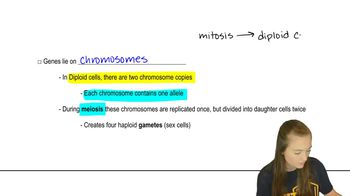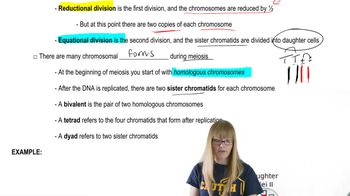Here are the essential concepts you must grasp in order to answer the question correctly.
Diploid Number
The diploid number (2n) refers to the total number of chromosomes in a somatic cell, which in this case is 36 for Geneticus introductus. This means that each somatic cell contains two sets of chromosomes, one inherited from each parent. Understanding the diploid number is crucial for comprehending how genetic information is organized and passed on during cell division.
Recommended video:
Mitosis vs. Meiosis
Mitosis is the process of cell division that results in two identical daughter cells, each with the same number of chromosomes as the parent cell. In contrast, meiosis is a specialized form of cell division that reduces the chromosome number by half, producing gametes. At the beginning of mitotic prophase, the somatic cell has the same chromosome number and DNA content as it does at the start of prophase I of meiosis, as both processes begin with diploid cells.
Recommended video:
DNA Content in Cell Cycle
The amount of DNA in a cell varies throughout the cell cycle. In the G₁ phase, a diploid cell contains a specific amount of DNA (3 ng in this case), which is duplicated during the S phase, leading to double the DNA content before mitosis or meiosis. At the beginning of mitotic prophase and prophase I of meiosis, the DNA content is the same because both processes start with cells that have completed DNA replication, ensuring that the genetic material is accurately distributed.
Recommended video:
 Verified step by step guidance
Verified step by step guidance Verified video answer for a similar problem:
Verified video answer for a similar problem:

